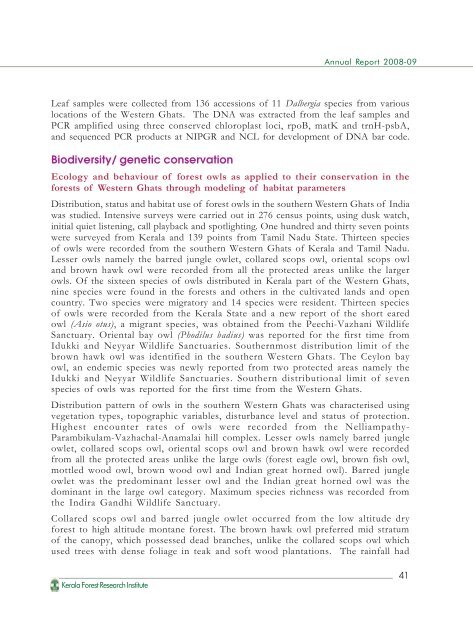2008-'09 - Kerala Forest Research Institute
2008-'09 - Kerala Forest Research Institute
2008-'09 - Kerala Forest Research Institute
You also want an ePaper? Increase the reach of your titles
YUMPU automatically turns print PDFs into web optimized ePapers that Google loves.
Annual Report <strong>2008</strong>-09<br />
Leaf samples were collected from 136 accessions of 11 Dalbergia species from various<br />
locations of the Western Ghats. The DNA was extracted from the leaf samples and<br />
PCR amplified using three conserved chloroplast loci, rpoB, matK and trnH-psbA,<br />
and sequenced PCR products at NIPGR and NCL for development of DNA bar code.<br />
Biodiversity/ genetic conservation<br />
Ecology and behaviour of forest owls as applied to their conservation in the<br />
forests of Western Ghats through modeling of habitat parameters<br />
Distribution, status and habitat use of forest owls in the southern Western Ghats of India<br />
was studied. Intensive surveys were carried out in 276 census points, using dusk watch,<br />
initial quiet listening, call playback and spotlighting. One hundred and thirty seven points<br />
were surveyed from <strong>Kerala</strong> and 139 points from Tamil Nadu State. Thirteen species<br />
of owls were recorded from the southern Western Ghats of <strong>Kerala</strong> and Tamil Nadu.<br />
Lesser owls namely the barred jungle owlet, collared scops owl, oriental scops owl<br />
and brown hawk owl were recorded from all the protected areas unlike the larger<br />
owls. Of the sixteen species of owls distributed in <strong>Kerala</strong> part of the Western Ghats,<br />
nine species were found in the forests and others in the cultivated lands and open<br />
country. Two species were migratory and 14 species were resident. Thirteen species<br />
of owls were recorded from the <strong>Kerala</strong> State and a new report of the short eared<br />
owl (Asio otus), a migrant species, was obtained from the Peechi-Vazhani Wildlife<br />
Sanctuary. Oriental bay owl (Phodilus badius) was reported for the first time from<br />
Idukki and Neyyar Wildlife Sanctuaries. Southernmost distribution limit of the<br />
brown hawk owl was identified in the southern Western Ghats. The Ceylon bay<br />
owl, an endemic species was newly reported from two protected areas namely the<br />
Idukki and Neyyar Wildlife Sanctuaries. Southern distributional limit of seven<br />
species of owls was reported for the first time from the Western Ghats.<br />
Distribution pattern of owls in the southern Western Ghats was characterised using<br />
vegetation types, topographic variables, disturbance level and status of protection.<br />
Highest encounter rates of owls were recorded from the Nelliampathy-<br />
Parambikulam-Vazhachal-Anamalai hill complex. Lesser owls namely barred jungle<br />
owlet, collared scops owl, oriental scops owl and brown hawk owl were recorded<br />
from all the protected areas unlike the large owls (forest eagle owl, brown fish owl,<br />
mottled wood owl, brown wood owl and Indian great horned owl). Barred jungle<br />
owlet was the predominant lesser owl and the Indian great horned owl was the<br />
dominant in the large owl category. Maximum species richness was recorded from<br />
the Indira Gandhi Wildlife Sanctuary.<br />
Collared scops owl and barred jungle owlet occurred from the low altitude dry<br />
forest to high altitude montane forest. The brown hawk owl preferred mid stratum<br />
of the canopy, which possessed dead branches, unlike the collared scops owl which<br />
used trees with dense foliage in teak and soft wood plantations. The rainfall had<br />
<strong>Kerala</strong> <strong>Forest</strong> <strong>Research</strong> <strong>Institute</strong><br />
41

















